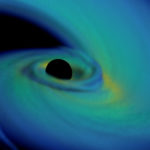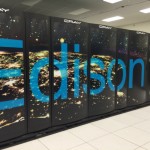In this video, researchers investigate the millennial-scale vulnerability of the Antarctic Ice Sheet (AIS) due solely to the loss of its ice shelves. Starting at the present-day, the AIS evolves for 1000 years, exposing the floating ice shelves to an extreme thinning rate, which results in their complete collapse. The visualizations show the first 500 […]
When Neutron Stars and Black Holes Collide
Working with an international team, scientists at Berkeley Lab have developed new computer models to explore what happens when a black hole joins with a neutron star – the superdense remnant of an exploded star. “If we can follow up LIGO detections with telescopes and catch a radioactive glow, we may finally witness the birthplace of the heaviest elements in the universe,” he said. “That would answer one of the longest-standing questions in astrophysics.”
Machine Learning and HPC Converge at NERSC
In this video from the Intel HPC Developer Conference, Prabhat from NERSC describes how high performance computing techniques are being used to scale Machine Learning to over 100,000 compute cores. “Using TB-sized datasets from three science applications: astrophysics, plasma physics, and particle physics, we show that our implementation can construct kd-tree of 189 billion particles in 48 seconds on utilizing ∼50,000 cores.”
Edison Supercomputer Helps Find Roots of MJO Modeling Mismatches
The MJO occurs on its own timetable—every 30 to 60 days—but its worldwide impact spurs scientists to unlock its secrets. The ultimate answer? Timely preparation for the precipitation havoc it brings—and insight into how it will behave when pressured by a warming climate.
Video: Optimizing Applications for the CORI Supercomputer at NERSC
In this video from SC15, NERSC shares its experience on optimizing applications to run on the new Intel Xeon Phi processors (code name Knights Landing) that will empower the Cori supercomputer by the summer of 2016. “A key goal of the Cori Phase 1 system is to support the increasingly data-intensive computing needs of NERSC users. Toward this end, Phase 1 of Cori will feature more than 1,400 Intel Haswell compute nodes, each with 128 gigabytes of memory per node. The system will provide about the same sustained application performance as NERSC’s Hopper system, which will be retired later this year. The Cori interconnect will have a dragonfly topology based on the Aries interconnect, identical to NERSC’s Edison system.”
Time-lapse Video: Edison Supercomputer Moves to Berkeley
In this video, engineers move the NERSC Edison Supercomputer from Oakland to Berkeley. The one week long move is condensed into :41 seconds in this time lapse video, shot during the entire process. Edison is a Cray XC30, with a peak performance of 2.57 petaflops/sec, 133,824 compute cores, 357 terabytes of memory, and 7.56 petabytes of disk.









